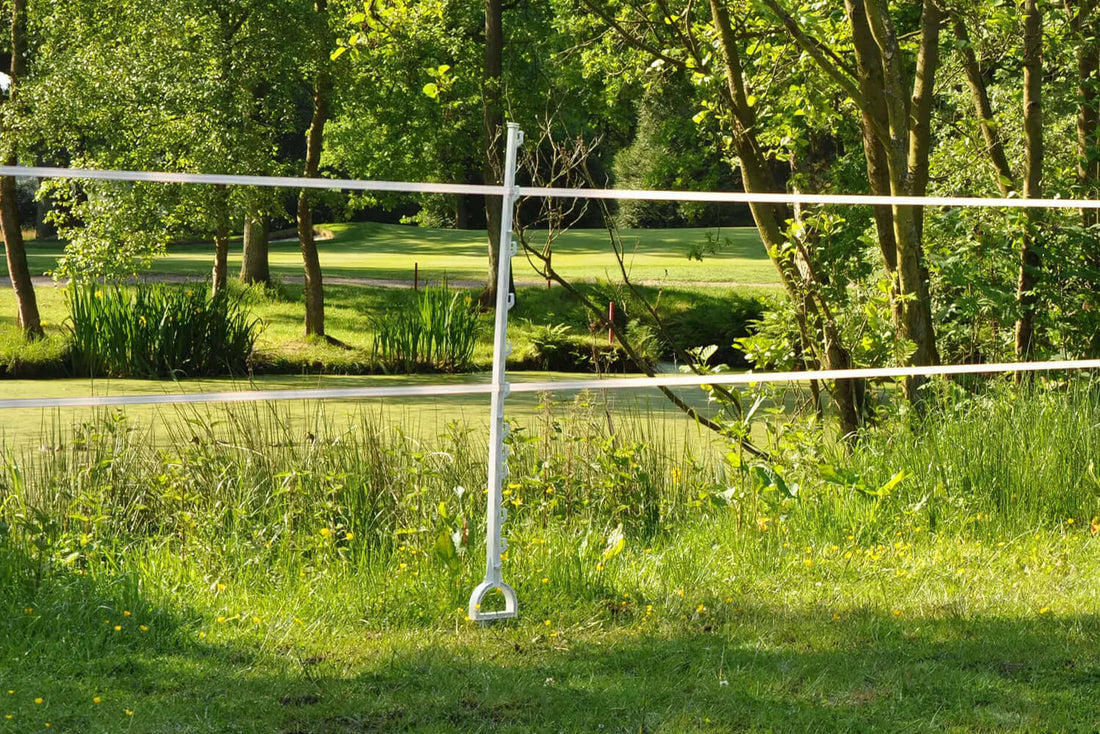
When setting up an electric fence, one of the most important decisions you’ll make is which electric fence posts to use. Posts are the backbone of your fencing system - they hold your wires, tape, or rope at the correct height and spacing, ensuring your fence works effectively to keep animals in or predators out. Whether you’re a smallholder, horse owner, farmer, or land manager, the right posts will make your fence stronger, safer, and easier to maintain.
In this guide, we’ll cover the different types of electric fence posts, how tall they should be, how many you’ll need, and tips for installation. If you’re ready to buy, you can browse our full range of electric fence posts at AgriSecure .
Types of Electric Fence Posts
Different posts are suited to different animals, terrain, and fencing goals. The main options include:
Plastic Electric Fence Posts (Polyposts)
Lightweight, affordable, and easy to move, plastic posts are ideal for temporary or mobile fencing. They usually feature multiple fixing points, allowing you to run wire, tape, or rope at different heights. Perfect for strip grazing, poultry runs, or quick setups.

Wooden Fence Posts
The traditional choice for permanent electric fences. Wooden posts are strong, long-lasting, and provide excellent stability, particularly for corners, gateways, and permanent paddocks. They usually require separate insulators to prevent short circuits.
Metal Fence Posts
Durable and highly resistant, metal posts are commonly used for permanent fencing. They’re especially useful in stony or hard ground where plastic or wooden posts might struggle.

Fibreglass Posts
Flexible, strong, and resistant to weathering, fibreglass posts are an excellent option for mobile or semi-permanent setups. They don’t rust and are easy to handle.
At AgriSecure, we stock a wide range of premium-quality plastic horse posts , heavy-duty wooden posts, and innovative step-in designs to suit every need.
How Tall Should Electric Fence Posts Be?
- The correct post height depends on the animals you’re containing:
- Horses: 120-140 cm posts (to place the top line at 115-135 cm)
- Cattle: 100-120 cm posts
- Sheep and Goats: 90-105 cm posts with multiple low lines
- Poultry/Predator Control: 110-120 cm posts with netting
Posts generally range from 50 cm (for small animals and gardens) up to 180 cm (for large horses or deer). Always choose a post height that allows you to set live wires at the right level for your livestock or the wildlife you want to deter.
How Many Electric Fence Posts Do You Need?
- The number of posts depends on the conductor material and terrain:
- Electric Fence Tape: space posts every 7-9 metres
- Electric Rope/Twine: 8-10 metres
- Polywire: 10-12 metres
- High Tensile Wire: up to 40 metres (with tensioners)

Uneven ground or corners will need closer spacing for stability. Remember to use strong end posts for corners and gates, and lighter step-in or plastic posts for intermediate sections.
Installing Electric Fence Posts
Plastic and step-in posts push straight into the ground, often with a footplate for easy placement. Wooden or metal posts may need pre-drilled holes or a post rammer for secure fixing. For permanent fences, spacing posts correctly and tensioning the wires is vital to prevent sagging.
At AgriSecure, our posts are designed for quick installation and durability, whether you’re building a temporary poultry pen, a permanent horse paddock, or a secure livestock boundary.
Why Electric Fence Posts Matter
A well-chosen post makes your fence more reliable, longer-lasting, and easier to maintain. They’re not just supports - they determine the height, safety, and effectiveness of your entire fence. By selecting the right post type and spacing, you’ll reduce maintenance, save money, and keep your animals secure.
FAQs About Electric Fence Posts
Q: What’s the best post for horses?
Tall plastic or wooden posts with tape up to 40 mm wide are ideal for horses, providing visibility and safety.
Q: How deep should electric fence posts go?
Temporary plastic posts are pushed 10-20 cm into the ground. Permanent wooden or metal posts should be driven 50-70 cm deep for stability.
Q: Can I mix different post types?
Yes - many farmers and horse owners use wooden posts for corners and gateways, and plastic posts for in-between runs.
Ready to get started?
Explore our full range of electric fence posts at AgriSecure and find the perfect solution for your farm, paddock, or smallholding.
Have a question?
Every electric fence setup is different and can present unique challenges. If you have any questions, our team is always here to help.